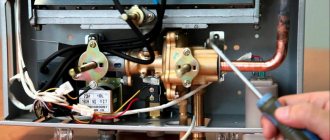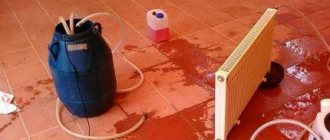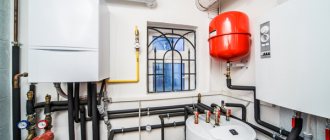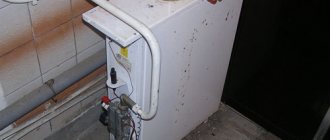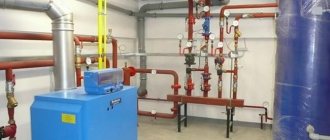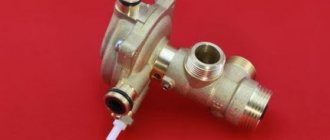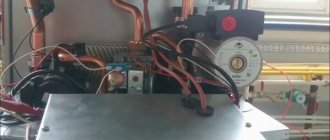Home / Gas boilers
Back
Published: 05/22/2019
Reading time: 2 min
17
60937
Gas boilers are designed to create comfortable living conditions. Double-circuit units provide the living space with heat and hot water at the tap. But it happens that a working boiler does not heat the water well and does not provide the necessary comfort.
The efficiency of the entire heating system depends on how the boiler operates. If there is a problem in the gas boiler itself, this can negatively affect the efficiency of the entire system and cause excessive consumption of energy resources. What happens when the boiler stops heating water? Let's look at the reasons and ways to solve this problem.
- 1 How does a boiler work?
- 2 The boiler does not heat water for heating
- 3 The boiler does not heat water for hot water supply
Gas pressure at the entrance to the house has decreased
A gas boiler may not reach temperature due to low gas pressure. Typically, a sensor is installed at the entrance to the boiler to measure pressure. First of all, its indicators are checked to make sure of this malfunction.
Also read with this article: What to do if the pressure in the gas boiler increases
Modern heating equipment is often equipped with a pressure reducer. Adjusting the values on it helps solve the problem described. For private houses with one or two floors, the optimal value is from 1.5 to 2 atmospheres. In houses with more than two floors, the gas pressure should be in the range from 2 to 4 atmospheres.
ATTENTION. Any boiler adjustment requires a careful approach with preliminary study of the instructions. Gas is a dangerous flammable component that can lead to explosions and fires if consumed incorrectly. If you doubt your own abilities, contact a company that services gas installations.
Why is the boiler boiling and how to fix this problem
Overheating of equipment is unsafe for both residents and the heating system, so it is important to diagnose the problem at the first sign and make the necessary changes to the functionality. Experts emphasize that it is important to take into account the type of working unit.
Most common situations
The most common source of the problem is an air lock in one of the nodes. It is necessary to carefully examine the entire system, focusing on the circulation of hot water. If a warm liquid comes from a pipeline instead of a hot one, it means that this is where an accumulation of air has formed. It is necessary to bleed excess air from the system using bleed valves. If this problem was not detected during the inspection, most likely the cause of the boiling lies directly in the functionality of the boiler.
Overheating of a boiler based on a gravity heating system can be caused by insufficient coolant circulation in the circuit. In this situation, you should place the expansion tank at the highest point in the house, in which case an additional load will be placed on the boiler and the required heated resource will be directed to it.
Experts recognize the most practical method of solving the problem as installing a circulation pump and equipping the heating system with a mixture circuit. Both types of devices allow you to reduce the load on the functionality of the heating device; cooled water will be added to the network. The boiler will receive return flow, which will provide natural cooling.
Causes of boiling in different types of boilers
In addition to insufficient circulation and airing, gas devices suffer from clogged filters: the latter need periodic cleaning or replacement. If exfoliated scale particles clog the duct, knocking and clicking sounds may be heard; here you need to clean the unit with special chemicals. Overheating can be caused by prolonged stagnation of the system and subsequent abrupt start-up (it is necessary to ensure preliminary testing of the ventilation engineering).
Actions relevant when a gas boiler is boiling:
- checking the complete circulation of the coolant and filters;
- monitoring the serviceability of radiator taps and the circulation pump;
- chimney draft control;
- cleaning the heat exchanger.
Solid fuel boilers overheat due to incorrect correlation of their power with the parameters of the room being served. The problem of increasing pressure in equipment caused by turning off the circulation pump is also often recorded.
Steam boilers seriously depend on the presence of liquid in them: due to the low level, the walls overheat, and an emergency situation occurs. Here you should stop supplying fuel, wait until the device cools down and add the working medium.
Why does an electric unit boil?
- scale clogging;
- a malfunction of the thermostat, causing the heating element to function even after the temperature increases;
- membrane malfunction;
- insufficient coolant;
- circulation pump failure;
- The return flow regulators are not open.
Overheating can be prevented by introducing a buffer tank that prevents the boiler from boiling; excess thermal energy will be directed into it. An uninterruptible power supply will allow you not to be afraid of turning off the control units and the pump. An additional circuit for a solid fuel boiler will allow for timely cooling. Experts also recommend periodically inspecting and maintaining (cleaning) the ventilation system.
The insertion was carried out poorly: the diameter does not match or there are narrowings in the gas pipeline
A common reason for a complaint that a gas boiler in a house does not heat well is poor-quality connection of heating equipment to the general gas supply system (gas pipeline).
Often, gas service workers weld an additional thread, screw a tap onto it and drill a small hole where the thread joins the gas pipe. The diameter of such a hole is much smaller than the diameter of the pipe, which leads to a drop in pressure. As a result, the gas boiler does not heat hot water well.
Correct connection requires compliance with certain rules and takes more time. Therefore, negligence occurs frequently.
You can determine this reason in the following way:
- there is a sharp decrease in the flame after ignition of the boiler;
- stops gaining temperature, or the flame goes out on its own.
Special calculators are used to calculate the required diameter of pipes in a particular room. The power of the boiler requires a larger volume of gas supply, therefore it is necessary to use pipes with a larger diameter. Before connecting the boiler to the gas pipeline, you must call a qualified specialist who will calculate the required diameter for the pipes, taking into account the characteristics of the room and the power of the boiler.
The following factors influence the choice of a larger cross-section in the connected pipes:
- low pressure requires connection to pipes with a large diameter;
- boiler power and room area affect the diameter;
- the longer the system, the larger the cross-section must be used;
- a reserve in diameter is necessary when there are many turns in the system (gas flow slows down at turns);
- number of consumed points;
- the required room heating temperature with the water heating temperature for domestic use;
- what pump is installed in the boiler.
Why the boiler does not heat well and does not reach temperature
No hot water? For what reasons does the equipment not work? Sometimes it's a matter of external factors. Let's take a closer look.
The device works, but does not heat or heats poorly
Airlock. Check to see if air has accumulated in the batteries. Use taps to remove excess air. If you don't have an air vent on your radiators, then you need to install one. By adjusting its tap, you can release the accumulated air in the system.
Also inspect the valve for blockages. Most often it becomes clogged with scale.
Clogged radiators . After cooling, drain the water from the pipes. If it is very dirty, run it through the batteries until it comes out clean.
Incorrect connection . If there is no hot flow, make sure that the diameter of the pipes corresponds to those stated in the instructions. Are the hoses connected correctly and the shut-off valves installed?
Low pressure in the line . It is not enough to open the valve and ignite the burner. Add water.
Scale accumulation in the heat exchanger. You may notice that the equipment takes a long time to heat up the liquid, and the batteries heat up slightly. Clean the radiator tubes from deposits. To do this, it is better to remove the unit, but this cannot be done in all models. Therefore, remove the casing and disconnect the device from gas and water. Connect the tubes from the pump to the heat exchanger and circulate the cleaning liquid through the system. Special products can be selected in the store. Then rinse the parts with running water.
Adding reagents to the coolant fluid helps reduce the formation of salts on parts.
When purchasing, it is important to pay attention to the brand and model of the boiler. For example, Electrolux, Arderia, Ariston, Buderus prohibit the use of the reagent. It is recommended to install cleaning filters or use distilled water.
Antifreeze can be applied to Baxi, Beretta, Vaillant, Proterm, Celtic, and Korea Star models. But a separate reagent is produced for each manufacturer.
Filter clogged . Another reason for poor battery warm-up. The mesh filter becomes clogged with small debris, so it is periodically removed and cleaned under running water. If the part is severely clogged or worn, it is better to replace it.
Incorrect adjustment . Check the set values on the panel. The temperature may be set too low, so the gas is not heating the hot water.
Problems with the operation of the circulation pump . Overheating, the pump turns off when hot water is turned on. Its power may not be enough for normal circulation. Adjust settings.
The battery design is not suitable for your equipment . Each design has its own permeability and heat transfer. An incorrect choice leads to a decrease in heating due to the permeability of the system.
Failure to comply with the slope of the highway . The problem is typical for systems with natural circulation, which is ensured by compliance with installation standards. According to the documents, the slope of the pipes for each linear meter must be at least 10 mm. No slope - no heating. The coolant stagnates, the batteries remain cold.
The gas boiler does not turn on, does not provide hot water for hot water supply
The main cause of malfunctions is salt deposition . The larger the scale layer in the heat exchanger, the worse the conductivity. The water takes a long time to heat up, and a thin, slightly warm stream flows out. Also, a piece of scale could break off and block the passage to the mixer. We described above what to do in this situation.
Problems with the flow sensor . The part works on the principle of a fan, which rotates due to the movement of the flow. The sensor may not work if there is a blockage. To clean without dismantling, open and close the tap located near the circulation pump.
If the procedure does not help restore operation, you will have to remove the sensor, clean it and reinstall it.
Three way valve malfunction . If the valve is jammed or broken, it will not be possible to switch the water supply from the heating system to the domestic hot water supply. The cause of the problem could be a clogged part, gas hose or filter. Clean all elements.
There are many reasons for malfunctions. The signs we describe will help you determine what problem has arisen in your circuit. Pay attention to the operation of the equipment and compare with the indicated problems. If you cannot fix the problem yourself, contact a specialist.
Discrepancy between the volume of water consumed and the power of the boiler used
If residents complain that there is no hot water coming from a gas boiler in a private house, the reason may be the fact that significantly more hot water is consumed than the boiler can physically heat. Heating hot water in a boiler is not an instantaneous operation. Therefore, the volume in the coolant must fully correspond to the amount of consumption.
The room is heated by water flowing in pipes (batteries). While it makes a full circle, it cools down. Therefore, during this time, a single-circuit or double-circuit gas boiler in a private house must heat the water for the next circle so that the circulation of the warm flow is continuous.
Expert advice on preventing extraneous noise and sounds
Some types of noise in heating communications can be removed independently or their occurrence can be prevented during the design and installation of heating.
If the batteries in a multi-storey building are connected without a bypass, during repairs it is impossible to change the pipes to communications of a smaller diameter. You cannot turn off the radiator using taps - you will leave your neighbors without heating, and they will not thank you for it. If there is no bypass, thermostatic valves cannot be used.
The recommendation of experienced plumbers is to use radiator taps, not radiator valves. Their design is more reliable, there is less hydraulic resistance, and there is no stagnant zone where debris accumulates. It is also better not to install valves. The advantage of using ball radiator valves is that the direction of water flow does not matter to them. In case of incorrect installation, the direction of the coolant flow will not affect them.
The video shows some ways to get rid of noisy heating pipes.
Too much draft in the chimney
High-quality supply ventilation in high chimneys leads to strong draft. Too much draft blows the flame away with strong gusts of wind, like outside.
Read more in the article: Why does the wind blow out a gas boiler?
Consequently, a gas boiler does not heat running water in the system well. To understand this reason, you need to imagine a burning fire in the middle of a field with a strong wind (the flame will also be blown out by the wind).
The normal indicator is changing the air in the boiler room three times. Sometimes, the indicator reaches ten or fifteen times during the period of heating the water for the next circle. Modern heating systems are equipped with special systems (dampers) that regulate draft. However, many older models remain sensitive to the force of the air flowing outside.
Clogged radiator
Sometimes the reason that the radiator does not heat can be a simple blockage. When determining the causes of blockage, let’s highlight the symptoms:
- It only warms around the perimeter.
- Only the top part.
- The bottom is heated, the top is not.
- Only a few sections out of all possible provide heat (if the bypass location is correct)
Could it be just the old battery that is clogged? Not at all. New systems (modern and ultra-modern, aluminum and cast iron) suffer from this just as often. The problem may lie in the general contamination of the system:
- From long-term use.
- Due to installation errors.
- Sediments with high water hardness.
- Erosion of system elements (oxide, rust).
How to get rid of it?
Modern heating devices with properly installed shut-off valves include an “American” valve, by turning off which the non-working part can be easily dismantled and cleaned, purged, and washed under pressure.
It’s harder where the equipment is “countless years old.” To disassemble, you may have to turn to specialists, emptying (preliminarily or with their help) the entire volume (usually just water).
Cast iron radiators can be cleaned. It is recommended to replace steel flat flow welded radiators with new ones of other models. But it is they, ironically, that are most often susceptible to rusting and clogging of channels - due to the design features and materials used. Therefore, they often do not heat properly. An additional reason not to clean this type of heating device is the risk of leakage of the eroded wall due to its thinning in the process of peeling off oxidized metal flakes. A leak can be costly (even if you forget about the cost of repairing the “junk”). This is the same case when the stingy one has every chance to pay twice, or even three times.
Interesting fact: cast iron radiators clog 3-5 times less often than aluminum or stamped ones.
Problems with setting the boiler gas valve
It is necessary not only to install the device correctly, but also to set up hot water on the gas boiler. If this is not done, the outlet pressure may be lower or higher than the specified norm, as well as a number of other errors made by unqualified specialists.
In this case, the device will operate at only part of its capacity. Consequently, heating in a room with a heating boiler will be less efficient. If this reason is identified, it is necessary to call specialists from the service company to eliminate the error.
We recommend reading with this article: How to properly configure a heating boiler
What should you do first?
First, check whether the wall-mounted boiler really does not heat the water. The design of any boiler involves technical limitations. This also applies to preparing hot water. A 24 kW gas boiler can heat 12 liters of water. The temperature difference will be around 35 degrees. You can clarify the technical characteristics of your device by reading the instructions for it. Any deviations from the parameters specified in it indicate a malfunction of the device. Some gas boilers today are equipped with a diagnostic system that displays an error code on a special display. The instructions will also help you decipher these codes.
Gas filter clogged
It is installed at the inlet of the boiler to further filter the incoming gas. Protects heating equipment from substances that cause malfunctions. A clogged gas filter delays the flow of gas, which reduces the combustion force, and accordingly the temperature in the house will drop.
The degree of contamination is assessed visually when the filter is unscrewed from the boiler. It is necessary to perform such a manipulation when the equipment is completely turned off.
Attention: A dirty filter must be replaced with a new one.
Boiler malfunctions
Typical problems with the operation of heating equipment:
- malfunction of the built-in pump;
- the heat exchanger is clogged;
- The three-way valve does not work.
If the boiler is working and the radiators are cold, experts recommend, first of all, assessing the technical condition of the main heating element. More specifically, determine whether the circulation pump built into the device is working. This part is an invariable attribute of modern equipment and is designed to increase the efficiency of its operation. Very often, after a long period of inactivity in the summer, the pump can become clogged or become covered with a layer of limescale. As a result, it does not remove the heated coolant from the heat exchanger in a timely manner. The boiler is boiling, but the radiators are cold.
It is strictly prohibited to independently repair such complex equipment as a boiler. In this case, either a specialist from the service center or a repairman with the appropriate certificate or permit is called to your home.
Experts do not recommend using ordinary tap water as a coolant, as it is hard. When the coolant temperature increases, dissolved salts settle on the heat exchanger. As a result, the following problem arises: the boiler is working, but the radiators are barely warm. Scale reduces the thermal conductivity of the heat exchanger, so the water in the circuit does not heat up, although the heating element constantly works with excessive energy consumption. You can fix the problem by changing the coolant and cleaning the heat exchanger. This video will help you understand how to clean the heat exchanger correctly:
A double-circuit boiler heats water, but does not heat the radiators. Here you need to pay attention to the serviceability of the three-way electric valve. It is responsible for switching the bypass from heating circuit maintenance mode to DHW and CO mode.
Before making a heating register with your own hands, familiarize yourself with the technical base.
Why can't antifreeze be used for radiators? The answer is here.
The occurrence of leaks in systems with automatic make-up
Automatic make-up systems are installed in powerful boiler houses serving industries and apartment buildings. In large private houses, sometimes they resort to a similar measure to strengthen the heating system.
The operating principle of automatic recharge is as follows. When the pressure of the incoming gas drops, the system turns on and maintains the required level for some time. The system is equipped with a pressure sensor, which it completely relies on for operation. For example, a water leak in pipes led to a drop in pressure. The make-up system pumps in a larger volume of new water to maintain pressure.
For some time, the system will retain heat. However, a large supply of new water will lead to the fact that the device will not have time to heat it and, accordingly, the boiler itself will not maintain the set temperature of hot water in the system.
what is this, photo of the circuit for this type, why does the water boil quickly in the expansion tank
The main difference between open or gravity systems (OS) and closed ones is that in the OS the coolant communicates with the surrounding air in an open expansion tank.
The coolant is in the system under atmospheric pressure, there is no excess pressure.
Odnoklassniki
Description of an open type heating system: what is it?
The OS heating circuit consists of a boiler located at the lowest point of the building - the basement or pit.
A vertical coolant supply riser extends from the boiler to the top point of the building (attic or attic), where the expansion tank (RB) is located.
Horizontal pipes with a slight slope extend from the RB along the top of the building to vertical risers, through which the coolant is delivered to the radiators.
The return line runs from the heating appliances at the bottom of the room, also with a slight slope towards the boiler.
Principle of operation
Schematically, the OS heating circuit can be represented as a long vertical ring. One side of the ring is with hot water (supply riser from the boiler to the boiler), the other side is with cold water (riser with return from the radiators). The density of a hot coolant is less than that of a cold fluid - water expands when heated.
Consequently, the weight of water and the pressure of the water column in the cold part of the circuit will be higher than the weight of water and the pressure of the column in the hot leg.
According to the law of communicating vessels, the liquid will tend to balance the pressures - to move from the cold branch to the hot one.
Heat exchanger clogged
Despite the fact that in every gas heating system, water purification filters are installed at the coolant inlet, the heat exchangers tend to become dirty. The cause of pollution is due to various natural impurities found in water. Salt and calcium deposits form on the walls, which are not so easy to clean. And if this is not done on time, then over time the heat exchanger will fail.
The shelf life also depends on the material. For example, the most durable ones are cast iron, although they are the most expensive. The most unreliable are steel ones. Their service life is only about 3 – 5 years.
You can read more about heat exchangers here: Which heat exchanger design and material to choose
You can find many cleaning methods on the Internet. Let's look at the two most popular ones.
Chemical cleaning of biothermal heat exchanger
Modern technologies use special chemical reagents to clean the bithermal heat exchanger. Before performing any manipulations, the boiler completely stops and cools down. Then the heat exchanger is removed. There may be water left in it, so it must be carefully drained.
In a container of sufficient size to completely immerse the heat exchanger, liquid with chemical reagents is diluted, then the bithermic heat exchanger is immersed. Cleaning time, solution concentration, and the need to use additional protective equipment (gloves) are indicated in the instructions for use for each individual reagent and depend on its chemical properties.
After this procedure, the hot water (heating) heat exchanger is washed under cold running water, dried, and installed in place. You can run it.
Chemical cleaning of the secondary heat exchanger
To chemically clean the secondary heat exchanger, you can use citric acid, active thermal agent, STEELTEXT Cooper, Detex liquid concentrate or hydrochloric acid. The choice of one or another component depends on the degree of contamination and the material from which the heat exchanger is made. It is necessary to pump 10 liters of solution to clean it thoroughly.
The process of removal and installation with cleaning is best left to professionals. Gas equipment is complex, despite its apparent simplicity, and dangerous for unqualified maintenance.
DHW does not heat up - causes and troubleshooting.
The most common reason why DHW does not heat up is severe scale formation inside the heat exchanger. Scale not only narrows the water flow in the heat exchanger, it significantly reduces the water temperature.
The reason for this is that the thermal conductivity of scale salts is many times less than the thermal conductivity of the metal from which the heat exchanger is made. The unit does not produce (does not supply) hot water or it flows poorly if a piece of plaque has broken off and blocked the flow of liquid.
Hot water does not flow into the tap when the flow sensor does not work. It is a fan that works when water flows through it. in this case, the signal from it is sent to the control board, which gives a command to heat the water. The sensor may become clogged; it can be cleaned without dismantling it.
The sensor is a cylinder located near the circulation pump. To clean, simply open and close the tap in front of the device. If this procedure does not produce results, you will have to dismantle it, clean it and put it in its original place. If the sensor is not working, you will have to replace it.
If the three-way valve is faulty, the unit will not produce hot water. The purpose of the three-way valve is to shut off the heating system when the hot water tap opens. When the valve does not switch, the boiler continues to heat water for heating.
The cause of a valve malfunction may be a simple blockage, for example, a piece of rust. If the problem is more serious, replace the valve with a new one. In addition, one of the simple reasons why hot water does not flow from the tap may be a clogged gas hose or gas filter.
Sectional view of a three-way valve
With heating this will not be so noticeable, but at the temperature of the water from the tap it will be more noticeable. Clean the hose and filters. Some of the points listed above may also be the causes of problems with heating and hot water in wood, electric and solid fuel (ST) boilers, provided the design details are similar.
Problems with the flow sensor
Heating equipment is equipped with various sensors. Among them are water temperature sensors, combustion sensors, flow sensors and others. A failed flow sensor leads to automatic shutdown of the boiler with a corresponding error message.
To determine the error by the displayed code, you need to look at the instruction manual. The identified cause is corrected by replacing the faulty sensor with a new one. To do this, it is recommended to call a service company.
We recommend reading: Why the gas boiler does not work, causes and troubleshooting methods.
Design and principle of operation of Hermann boilers
Hermann Habitat 2 (Herman Habitat 2) is a domestic double-circuit boiler designed for heating buildings up to 280 square meters. It is light in weight and small in size, which makes it indispensable for installation in small spaces such as a corridor or kitchen.
It is equipped with automatic control of water heating and ignition, and in addition, a system to prevent the formation of scale in the heat exchanger. Efficiency up to 16 liters per minute. There is special protection against overheating and maintaining traction. If voltage surges occur in the electrical network, the gas supply stops.
Hermann Habitat 2 boiler control panel
Hermann Micra 2 (Herman Micra 2) is a gas double-circuit boiler with a secondary plate heat exchanger. It is also large in size and equipped with automatic flame control and a system that prevents smoke from escaping outside.
The dashboard allows you to regulate the temperature using only two mechanical regulators. Designed for wall mounting and has built-in ionization electronic control of ignition and combustion. Ensures constant heating of water and coolant.
Hermann Thesi 23 E is a new series model with a capacity of up to 30 kW. Has the function of controlling the boiler from a distance. The system has two heat exchangers, which ensures instant hot water supply. Efficiency is about 17 liters per minute. Automatically recharges when pressure drops.
The hot water temperature sensor is faulty
The second most important sensor measures the temperature in the water supply system in the house. This malfunction can cause the faucet in the house to supply water that is too hot or not hot enough.
When turning on the water on the faucet, a person does not think about possible malfunctions and can easily get burned. Therefore, this malfunction leads to the boiler stopping with the corresponding error being displayed. Some manufacturers do not equip boilers with a stop system in case of this malfunction, so consult with specialists which equipment to choose before purchasing.
How does a boiler work?
To understand the situation more clearly, you need to understand the principle of operation of the boiler. Double-circuit gas wall-mounted boilers such as Baksi or Ariston consist of several components. In the gas part, the incoming fuel is burned, the water part ensures the supply of heated water from the heat exchangers to the heating system, and the smoke removal part is responsible for removing combustion products outside the home.
Depending on the user settings, temperature sensors adjust the water heating mode. A sensor on the return pipeline turns off the boiler, depending on the achievement of the required temperature set for the return. However, the system pump does not stop running until the heat exchanger temperature drops.
This is provided to prevent the water from boiling in it. As soon as the coolant cools down to the maximum level, the electronics will send a signal to turn on water pumping and the gas valve. The whole process will start again. When you open the tap in the mixer in a double-circuit boiler, a flow sensor reacts, which informs the electronics about the need to switch the three-way valve to the mode of heating water for DHW.
When the hot water tap is turned off, it returns to heating mode. Some manufacturers provide heating for both heat exchangers during periodic switching.
Excess power
Excess power, as well as its lack, negatively affects the heating device. It can also lead to overheating and other problems. Therefore, the device stops in emergency mode and displays the corresponding error. You can try restarting the heating equipment. However, first, it is better to understand the reasons and eliminate them.
In conclusion, it should be noted that some faults can be determined independently by the method of elimination. Errors shown by the boiler are always described in its documentation. But it is not recommended for people without certain qualifications to interfere with the operation of the device.
Incorrectly selected boiler power
The next reason for insufficient temperature rise is the opposite of the previous one. This is the case when the volume of water is calculated correctly, but the boiler power does not match.
The volume of water generally depends on the number and volume of all heating devices and pipe circuits installed in the system, additional buffer tanks, separators, etc. If, based on the volume of coolant, the boiler has insufficient power, as in the previous described situation, the boiler will not have time to warm up this entire volume.

